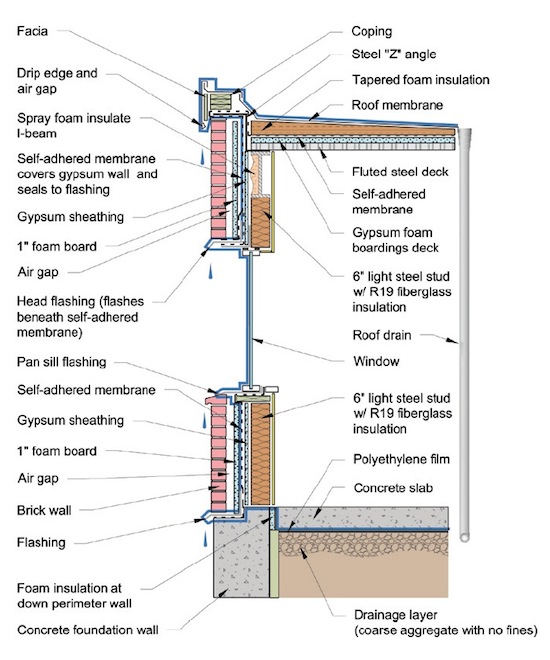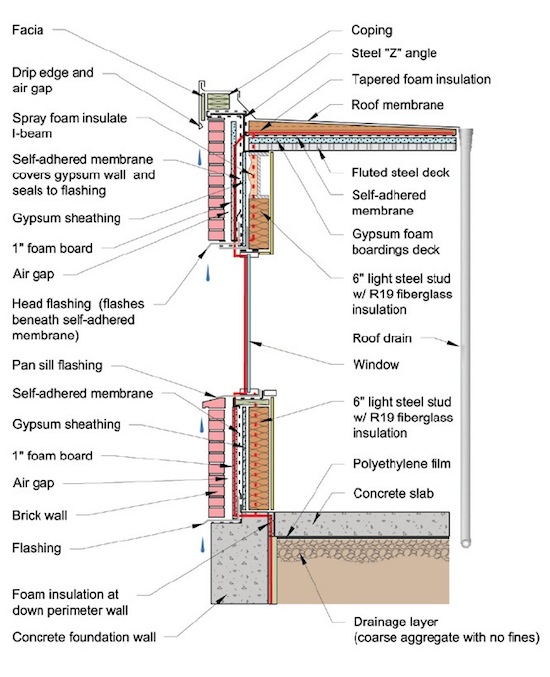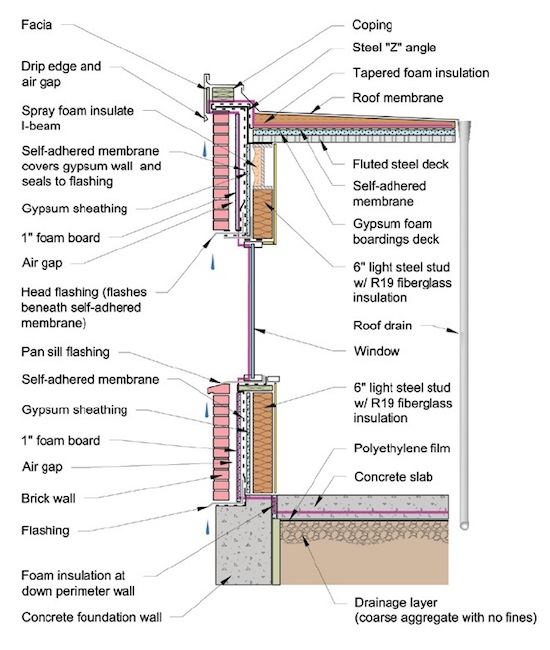The Pen Test — A Control Layers Tool for Architects and Contractors

I listened to the IAQ Radio podcast a couple of weeks ago when they interviewed Lew Harriman and Terry Brennan, who were discussing the new moisture control guide published by the EPA last year. Brennan is the lead author of the document, and it’s a really great resource full of useful information about indoor air quality, fundamental building science principles, and how to control moisture. If you have anything to do with buildings, you really should download it now and read it.
The pen test
One of the most important tools in the guide is the pen test described in Appendix A. It’s something that should be done on every building, by the architect during design and by the contractor before and during construction. It’s both simple and powerful and can prevent a lot of problems down the road.
To do the pen test, you simply pick a spot on a section in the plans and trace the control layers for liquid water (rain), heat, and air. (They don’t discuss doing the pen test for the water vapor control layer. It’s more complex because it’s generally more important for assemblies to be able to dry than it is to stop water vapor and because it’s the cumulative effect of all the layers in an assembly that determine how much water vapor will get through.) If you have to pick up your pen at any point, you’ve discovered a flaw in that particular control layer.
Rain, heat, and air control layers
Below are the three pen test diagrams from the EPA moisture control guide. The first shows the liquid water control layer in blue. You can follow it from the roof membrane all the way down to the polyethylene sheet under the slab in this section. Anywhere you have a transition from one material to another or where the openings are, you need to pay special attention. Notice the different flashings and drip edges in this diagram.
The second diagram shows the heat control layer, which some people like to call insulation. Just follow the red line to see where the insulation is. In this case it really does need to be continuous because the structure of the building includes steel studs. Cavity insulation only would cause major problems.

The final diagram here shows the air control layer in purple. Controlling air leakage is huge, so make sure you design the details until you can draw without lifting that pen.

One final note about the pen test: It starts with design. The builder then goes over the plans and makes sure they understand how to do it right. But then comes the most important part: execution! Once construction begins, all kinds of unanticipated obstacles pop up. Changes get made on the fly, and what was a continuous line on paper now gets chopped up. And that’s where the pen test shows its real value.
The most important outcome
When architects and contractors train themselves in using the pen test as a tool with their plans, it really is just that — training. Yes, you want to use it to find and design out problems from the start, but even more important is to be able to look at the building as it’s going up and seeing the continuity—or lack thereof—in the control layers.
Your plans may not show a section with a critical flashing detail. Or maybe an electrician cuts a penetration that wasn’t on the plans. This is where that training pays off and you can look at the building with “pen test eyes.”
Related Articles
Combobulating the Perfect Wall – The Basics of Control Layers
Be a Controlling Building Enclosure Control Freak with Control Layers
A Building Enclosure Double Disaster – Control Freaks Missing Again
NOTE: Comments are moderated. Your comment will not appear below until approved.
This Post Has 6 Comments
Comments are closed.

I just downloaded that one.
I just downloaded that one. I’m still finishing the 2008 Read This before you design or build from BSC.
Great Stuff here as usual. Thank You for Sharing.
Allison, you are getting so
Allison, you are getting so good at this its a bit frightening. Thanks for quality content.
Great post. Really useful
Great post. Really useful way to think about it. I am going to share this one. Thanks, Allison.
I see a small flaw, though, and I think you can turn it into another post/article. Let’s stop calling for using a sheet of polyethylene for the under slab vapor barrier. There are much better products /systems available. I usually call for a “Stego Wrap” system, but there are other equal products available. Polyethylene will probably not survive the construction process / concrete pour intact, and even if it does it will probably deteriorate in a few years. And who tapes the seams / seals the penetrations in polyethylene? Think about the vapor barrier as the under slab Tyvek. It is a system & all of the seams & holes need to be sealed. Concrete will absorb moisture if it has the opportunity. Another case of no one will call to tell you your slab is dry & there are no problems, but if it gets wet & starts ruining finish materials you will get a lot of calls. A good vapor barrier is cheap insurance for Architects & Contractors.
Great post Dr. Bales. I would
Great post Dr. Bales. I would be very interesting in the approximate dimensions of the air gap spaces. Also, what improvement in performance might we observed with the continuation of insulation under the slabs.
Interesting enough the PEN
Interesting enough the PEN test has been codified in the 2015 IECC for the thermal envelope.
Gary, I think you’ve confused
Gary, I think you’ve confused a vapour barrier with an air barrier. The vapour barrier under a foundation slab doesn’t need to be sealed because the concrete slab is an air barrier and vapour diffusion through the slab is governed by its exposed area, which is negligible even if the vapour barrier has holes and untaped seams. Granular fill beneath the vapour barrier provides the capillary break needed to prevent bulk wetting, assuming there’s somewhere for water to drain to. Dr. Lstiburek explains it at http://www.buildingscience.com/documents/insights/bsi-003-concrete-floor-problems.